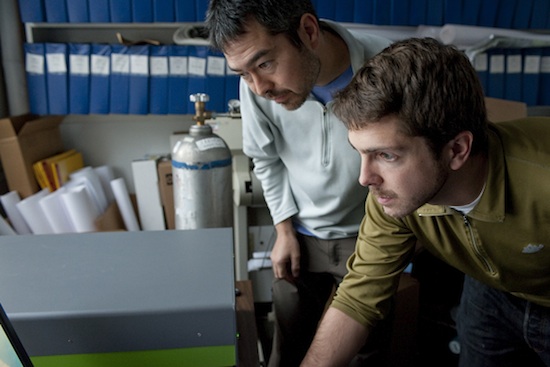Sizing Up Carbon Emissions
BU researchers get grant to study area’s footprint

Calculating your carbon footprint online involves nothing more than a couple of mouse clicks. Measuring the carbon footprint of a city? That takes more detective work.
Boston University researchers are on the case. Nathan Phillips, a College of Arts & Sciences associate professor of geography and environment and director of the Center for Energy and Environmental Studies, and his colleagues received a $300,000 grant in September from the National Science Foundation and the U.S. Forest Service to study the flow of carbon in and out of Boston. Beyond learning how to quantify and predict carbon levels, they want to inform policy decisions on carbon emissions and urban sustainability.
Baby steps first, with a focus on measuring carbon activity above Commonwealth Avenue. Phillips and his team must prove over the next 30 months that their “urban metabolism” project has legs.
“I liken it to time trials for the Olympics,” Phillips says. Should his team make the cut, it could receive money to expand research from its BU hub to all of Boston.
They want to explore all aspects of carbon exchange, from measuring breath and photosynthesis to measuring emissions and energy consumption.
Doing so requires gadgets. On the fourth floor of 675 Commonwealth Avenue, the whirring sound of a pump fills the room. A clear tube snakes from one end, out a window, and up to the roof. Another tube leads to something called a Picarro system, which looks like a cable box on steroids. A graph on a nearby computer screen displays a wave of scribbles.
The Picarro measures carbon dioxide; its signature suggests where it could be coming from — car exhaust, for example, or simply human breath. The $60,000 machine, on loan from the U.S. Forest Service, takes readings every seven seconds and plots them on a graph. On a recent weekday midmorning, it reads at 404 parts per million, slightly above the global average of 385 parts per million, Phillips says.
Another Picarro, also a Forest Service loan, is located at Harvard Forest, in Petersham, Mass., to see how carbon dioxide levels vary from urban to rural areas.
Phillips is finding that carbon dioxide levels are higher during weekdays and peak around high commuting hours. Not surprisingly, readings at Harvard Forest are consistently lower than those at BU.
 On the rooftop, Phillips has an antenna-like gadget that measures wind direction, temperature, humidity, light, and carbon levels. Webcams at Marsh Plaza also give glimpses of traffic flow. He hopes to use a canopy lift in warmer months to measure the carbon exchange of leaves.
On the rooftop, Phillips has an antenna-like gadget that measures wind direction, temperature, humidity, light, and carbon levels. Webcams at Marsh Plaza also give glimpses of traffic flow. He hopes to use a canopy lift in warmer months to measure the carbon exchange of leaves.
Additional investigators in the department of geography and environment, such as Sucharita Gopal, Robert Kaufmann, Mark Friedl, all professors, and Lucy Hutyra, an assistant professor, will gather data. Researchers from many other University departments will also contribute.
Les Kaufman, a CAS professor of biology and associate director of the Boston University Marine Program, has joined Phillips’ study. He says carbon, the “backbone” of life, is key to studying how the urban metabolism impacts Boston Harbor and beyond.
“Following the carbon is like following the money,” he says. And a lot of carbon, in many forms, winds up downstream. “Everything gets flushed into the ocean.”
Kaufman plans to use cameras, sensors, and molecular probes to gather information for what amounts, he says, to “placing a value on the ocean taking care of itself.”
Many institutions, among them Harvard University, MIT, the U.S. Forest Service, and the Boston Metro Planning Organization, will also contribute brainpower and research.
“It’s like a home energy audit, but we’re doing it on a much larger scale,” Phillips says.
One goal is to create a high-resolution map of Boston. Red spots would indicate carbon emission zones, Phillips explains, and green spots would reveal carbon uptake zones. Color intensity might show ongoing carbon hot spots. The graphic could predict how human activity or policy changes affect carbon concentrations.
Boston officials have pledged to reduce carbon emissions to 7 percent below 1990 levels by 2012 and to increase tree canopy cover from 29 percent to 35 percent by 2030; trees reduce carbon and add oxygen. BU-led research could define where best to focus to achieve those goals and could measure success.
Getting people to implement the research is a challenge. Douglas Zook, a School of Education associate professor and director of the science education program, another member of Phillips’ team, says people respond more to crises than to scientific warnings.
“How do you get people to be responsive and realize how important it is to control gas emissions and develop a city that is sustainable, healthy, and vibrant?” asks Zook. “It really comes down to education.”
Leslie Friday can be reached at lfriday@bu.edu.
Comments & Discussion
Boston University moderates comments to facilitate an informed, substantive, civil conversation. Abusive, profane, self-promotional, misleading, incoherent or off-topic comments will be rejected. Moderators are staffed during regular business hours (EST) and can only accept comments written in English. Statistics or facts must include a citation or a link to the citation.